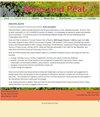Revegetation of upland eroded bare peat using heather brash and geotextiles in the presence and absence of grazing
IF 1.5
4区 环境科学与生态学
Q4 ENVIRONMENTAL SCIENCES
引用次数: 2
Abstract
Revegetation of eroded bare peat is commonly facilitated by the import of artificial resources and genetic material (lime, seed and fertiliser), but such techniques are less suitable for remote upland locations with sensitive local flora. Using a BACI (Before-After-Control-Impact) approach, this study explores the effectiveness of alternative treatments (heather (Calluna vulgaris) brash cut onsite and two types of geotextiles) in the following four years at grazed and ungrazed sites at Ben Lawers National Nature Reserve. After an initial colonisation, the mean vegetation cover in grazed plots degraded to 9.4 %, demonstrating that restoration using these methods is impeded by trampling impacts of large herbivores. The vegetation cover and number of indicator species increased annually at the ungrazed site. A significantly greater cover (>85 %) occurred at plots where thick brash (>85 % ground cover) had been topped with GeoJute netting, but plots with only heather brash still reached 56.6 % cover. It provided a suitable seed source and colonising substrate for appropriate local peatbog species, while additional planting of C. vulgaris cuttings did not significantly increase vegetation cover in comparison to unplanted plots. These results show that short-term restoration of bare peat can be promoted using minimal interventions and onsite resources in the absence of grazing.在有无放牧的情况下,利用石南灌木和土工布对高地侵蚀的裸泥炭进行植被恢复
进口人工资源和遗传物质(石灰、种子和肥料)通常有助于侵蚀裸泥炭的恢复,但这些技术不太适合当地植物敏感的偏远高地地区。本研究采用BACI(前-后-控制-影响)方法,在接下来的四年中,在Ben Lawers国家自然保护区放牧和未放牧的地点,探讨了替代处理(石南花(Calluna vulgaris)现场切割和两种土工布)的有效性。在最初的殖民化之后,放牧地的平均植被覆盖率下降到9.4%,这表明使用这些方法的恢复受到大型食草动物践踏影响的阻碍。未放牧地植被覆盖度和指示物种数量呈逐年增加趋势。在地面覆盖度为> 85%的地面覆盖度的地块上,盖度显著提高(> 85%),而仅覆盖石南芥的地块盖度仍达到56.6%。它为当地适宜的泥炭物种提供了合适的种子来源和定殖基质,而与未种植的样地相比,额外种植柽柳插条并没有显著增加植被覆盖。这些结果表明,在没有放牧的情况下,使用最少的干预措施和现场资源可以促进裸泥炭的短期恢复。
本文章由计算机程序翻译,如有差异,请以英文原文为准。
求助全文
约1分钟内获得全文
求助全文
来源期刊

Mires and Peat
ENVIRONMENTAL SCIENCES-
CiteScore
2.30
自引率
16.70%
发文量
0
审稿时长
33 weeks
期刊介绍:
Mires and Peat is a peer-reviewed internet journal focusing specifically on mires, peatlands and peat. As a truly “free-to-users” publication (i.e. NO CHARGES to authors OR readers), it is immediately accessible to readers and potential authors worldwide. It is published jointly by the International Peatland Society (IPS) and the International Mire Conservation Group (IMCG).
Mires and Peat is indexed by Thomson Reuters Web of Science (2017 Impact Factors: 1.326 [two-year] and 1.638 [five-year]), Elsevier Scopus, EBSCO Environment Complete, CABI Abstracts, CSA Proquest (including their Aquatic Science and Fisheries Abstracts ASFA, Ecology, Entomology, Animal Behavior, Aqualine and Pollution databases) and Directory of Open Access Journals (DOAJ). Mires and Peat also participates in the CABI Full Text Repository, and subscribes to the Portico E-journal Preservation Service (LTPA).
Mires and Peat publishes high-quality research papers on all aspects of peatland science, technology and wise use, including:
ecology, hydrology, survey, inventory, classification, functions and values of mires and peatlands;
scientific, economic and human aspects of the management of peatlands for agriculture, forestry, nature conservation, environmental protection, peat extraction, industrial development and other purposes;
biological, physical and chemical characteristics of peat; and
climate change and peatlands.
Short communications and review articles on these and related topics will also be considered; and suggestions for special issues of the Journal based on the proceedings of conferences, seminars, symposia and workshops will be welcomed. The submission of material by authors and from countries whose work would otherwise be inaccessible to the international community is particularly encouraged.
 求助内容:
求助内容: 应助结果提醒方式:
应助结果提醒方式:


